Metal Roof Retrofit on a Hurricane Damaged Home
by:
Dave Chasar, PE
 |
1,700
sqft Home with White Metal Roof |
The author’s 1,700 square foot home in Cocoa, Florida was damaged in the summer of 2004 by hurricanes Frances and Jeanne. A white metal roof was chosen to replace the damaged shingles to reflect summer heat and thereby reduce cooling energy use. In this application the shingles were not removed but left in place below the newly installed metal.
Measured Savings
A before/after
energy comparison was made possible with monitored data collected at
the home over several years. Indoor, outdoor and attic temperatures
along with air conditioner energy use and runtime were analyzed to
assess performance. Initial results for a nine week period in the summer
of 2005 show the white metal roof providing a 19% savings in air conditioner
energy over the same period in 2004 when shingles were in place. Similar
savings were seen in a more rigorous 2002 study comparing side-by-side
homes in Ft. Myers, Florida.
See: http://www.fsec.ucf.edu/en/publications/html/FSEC-CR-1220-00-es/index.htm
Measured
9-Week Performance Highlights June 25 - August 31 |
|||
| - | Dark
Shingle 2004 |
White
Metal 2005 |
Reduction |
| Cooling Energy (kWh) | 2,170 |
1,749 |
393 |
| Cooling Cost (@ $0.10/kWh) | $217 |
$175 |
$42 |
| Cooling Cost Savings | 19% |
||
| Avg. Peak Attic Temperature (°F) | 111°F |
96°F |
15°F |
| Avg. Peak Ambient Temperature (°F) | 89.4°F |
88.6°F |
- |
| Notes: Energy estimate based on linear fit accounting for ambient temperature difference. | |||
The figure below shows the effect on cooling energy use by plotting daily air conditioner energy against the difference in indoor and outdoor temperature. This approach helps account for the difference in average outdoor temperature between 2004 (79.5°F) and 2005 (82.5°F).
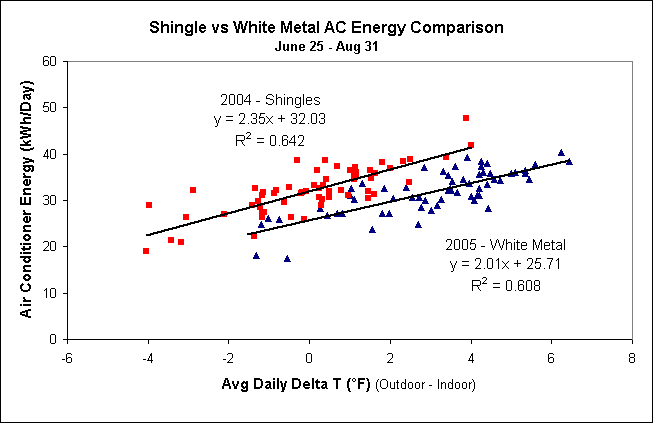
Cooling Energy Scatter Plot with Linear Trend
The average-day plot illustrates the effect of the white roof on attic temperature and cooling power. In this plot, average values of temperature and power for each hour over the 9-week data period results in an “average” 24 hour profile. The attic is noticeably cooler with the white metal roof (15 degrees at peak) during the day but is actually warmer at night, due to the warmer nighttime temperatures in 2005.
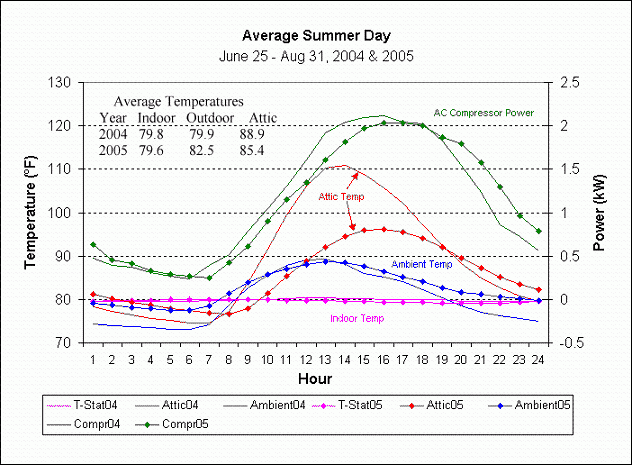
Average Daily Performance: Shingles vs. White Roof
Material Costs
The new
roof was purchased and installed by the author. A three foot wide,
exposed fastener, steel panel proved the most economical choice that
included galvalume substrate and Kynar paint finish. Galvalume is an
aluminum-zinc alloy that has shown improved performance over galvanized
roofing in tests conducted by BIEC
International (also GalvInfoNote12).
Kynar is a fluoropolymer paint available through many manufacturers
and reputed to outlast sliconized polyester based paints. Warranties
were found to be generally longer on Galvalume and Kynar products than
with typical galvanized metal panels. The product purchased for this
project came with a 40-year warranty on the finish.
Metal
Roofing Material Costs (homeowner purchased) |
||
| 26 ga, 3 ft, exposed fastener, Galvalume panel w/ Kynar paint (includes flashing, gutters and screws) | 4,100
sqft |
$
6,300 |
| Synthetic Underlayment (5-1,000 sqft rolls) | 5,000
sqft |
$
750 |
| Skylight Flashing | 2 |
$
150 |
| Caulk & Pipe Boots | - |
$
200 |
| Total | $
7,400 |
|
A shingle
replacement estimate was obtained through an insurance adjuster. The
estimate included all material and labor costs with a 29% profit margin
and special increases associated with post-disaster market conditions.
Estimated
Shingle Replacement Cost - Material + Labor (includes "special market conditions" increase) |
||
| Material | ||
| Dimensional Shingle | 3,900
sqft |
$
6,500 |
| 30lb Felt Underlayment | - |
$
550 |
| Miscellaneous flashing/boots | - |
$
700 |
| Labor (including shingle removal) | - |
$
4,200 |
| Total | $11,950 |
|
The cost comparison shown here is an isolated example in a local market impacted by conditions following unusual hurricane activity. Material and labor price instability are expected under such circumstances and will certainly vary from one situation to another but are presented here for comparison purposes.
Economic and Other Benefits
While metal and shingle roofing costs vary with choice of material and difficulty of installation, metal roofing is generally more expensive than shingles. The energy savings shown here would take many years to offset the increased cost of metal but there are other benefits to consider.
Benefits of Metal Roofing over Asphalt Shingles
- Lasts about 3 time longer (50 yrs vs. 17 yrs)
- Resists harsh weather, wind and fire
- Possible insurance discounts to homeowners (none in this case)
- Minimum 25% recycled content (as high as 50%)
- 100% recyclable at end of useful life
http://www.metalroofing.com/ (Metal
Roofing Alliance)
http://www.wbdg.org (National
Institute of Building Science)
Installation
Codes in many jurisdictions allow for at least two layers of roofing material before removal of existing cladding is required. The determining factor for removal is the weight of material and metal roofing meets the requirements with less difficulty as it is far lighter than shingles on a per square foot basis. Shingle removal is labor intensive and the material must be hauled away. The existing shingles, in this case, were left in place since damage was limited to individual shingle tabs and there was no major exposure of underlayment or roof decking.
Two options were considered for installing metal over shingles: (1) install 1x4 purlins or battens over the shingles prior to affixing the metal, and (2) install new underlayment over the shingles and then affix the metal panels directly to the shingles. In either case, manufacturer’s recommendations should be followed as some products are designed for installation over solid decking while others can be installed on open framing. For this project, 5-foot wide synthetic underlayment was nailed to the shingles followed by fastening of the metal panels. The major drawback of this approach was a marked increase in “oil-canning”, a common imperfection in metal roofing related to wrinkling of the panels upon installation. While some amount of oil-canning can be expected in any installation its presence does not generally influence performance.
The existing drip edge was removed to prepare the roof. Since the existing shingles were to remain in place, only the outer portion of the drip edge was removed by cutting with a sacrificial blade. The cut was made through both the shingles and drip edge metal and slightly into the roof itself, leaving a small portion of the bare roof exposed (photo 1). This allowed the new drip edge to rest flush against the fascia like the original before being nailed in place over the remaining shingles.
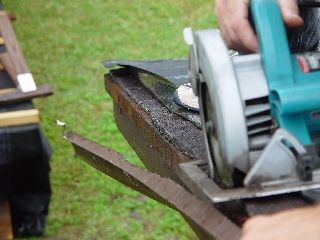
Photo
1 - Existing drip edge cut with circular saw
Roofing underlayment was applied directly to the shingles in a standard overlap pattern (photo 2). Lightweight synthetic material in 5-foot widths made for an easier installation than heavier 30-lb felt which is 3-feet wide.
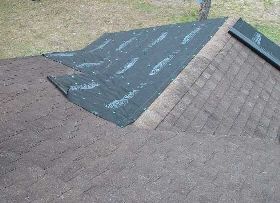
Photo
2 - Underlayment applied over shingles
The new drip edge was positioned against the fascia and fastened on top of the remaining shingles. (photo 3).
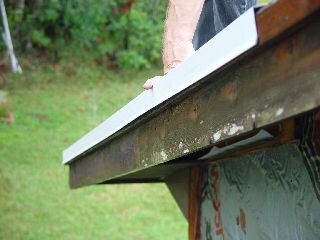
Photo
3 - New drip edge installed
Finally, with the new drip edge and underlayment in place, the metal panels were installed (photo 4).
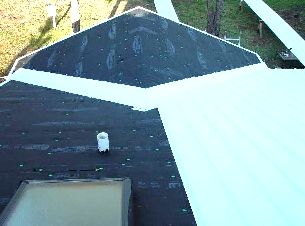
Photo
4 - Underlayment and metal installed over old shingles
In Conclusion
The 3-foot wide, exposed fastener panel was chosen primarily to reduce labor but also proved to be the most economical choice with the desired characteristics (galvalume substrate & kynar finish). A standing seam product from the same manufacturer would increase panel costs by about 50% in exchange for a neater and perhaps more appealing look with concealed fasteners.